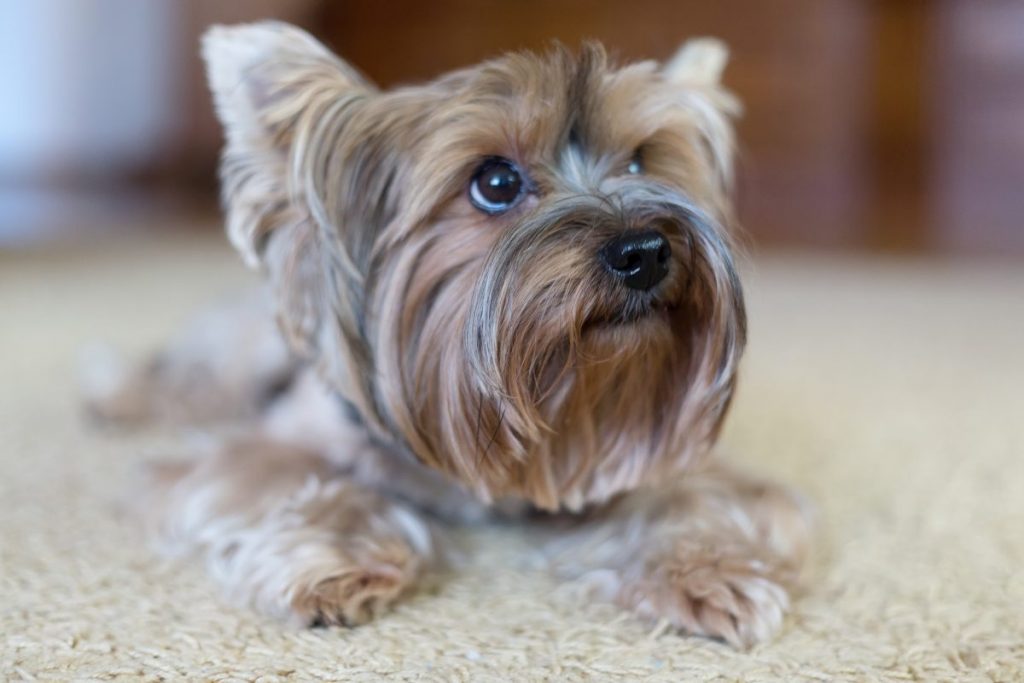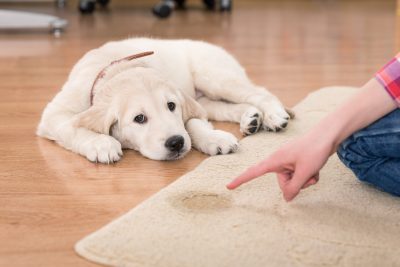Training your dog to go to the bathroom in the proper place can be a difficult task that takes a lot of time and patience. Remember, puppies are brand new to the world, and peeing or pooping is a natural and somewhat unconscious act for them. When your dog has to go, they do. Therefore, it is essential to provide your pup with a proper area to do his business and teach him to go there through repetition and positive reinforcement.
It’s up to you, the dog owner, to decide where you would like for your dog to do his business. There are two options: outside or inside. Outside is preferable of course, but not every dog owner has a yard, or the ability to walk their dog 3 times a day. In some cases, designating an inside spot might be your best option.
Inside or Out?
If you have the ability and the room, training your dog to go outside is preferable. You may, however, have certain outdoor spaces you don’t want your dog to go. Simply letting your dog outside to go wherever he pleases can end up being a mistake. If you give your dog free reign of the yard for bathroom purposes, expect him to explore the space.
You’re better off designating a specific part of your yard that is easy to clean – and has minimal foot traffic. If you don’t have easy access to an outdoor space for your dog to do his business – or any access at all – you made need to consider alternative options, including the “pee pad.”
Many dog owners live in high-rise buildings with no access to a yard, and little access to grass. If you are an apartment dweller, a smaller dog is probably best for you. They need less exercise (or at least they need less space to exercise), they take up less space and, perhaps most importantly, their droppings are less significant than medium-sized or large dogs. Regardless of what size dog you have, teaching him to go in a specific space – whether that’s a pee pad or outside – is paramount to both you and your dog’s happiness.
Should You Use Pee Pads?
There are differing opinions on whether training your dog to go on a pee pad is a good idea or a bad one. Each situation calls for different solutions. In many cases, potty pads can be a great option for dog owners, including:
Apartment Dwellers: If you live in a high-rise apartment, getting your dog down the elevator and out the door to do his business 3-6 times a day can be very difficult, especially if you live in a cold weather climate.
Convalescent Dogs: Pee pads aren’t just for small dogs and puppies. Older dogs who are convalescent have lost the ability to control their bowels. Letting them go on a pee pad is both necessary and empathetic. Your dog wants to please you, and when he gets past the point of his life where he can control himself, supporting him both physically and emotionally is important. Pee pads can help you do that.
Fearful Dogs: Many rescue dogs have been treated poorly, or have had minimal human contact. This can cause intense fear, which can include fear of going outside to relive themselves. If your rescue dog is cowering under a desk, offer him a pee pad to help him come out of his shell slowly and begin to trust you.
Owners with Mobility Issues: It’s not just dogs that may have issues getting themselves outside. Many dog owners have health and mobility issues that prevent them from easily getting their dogs in and outside every time they have to go. Pee pads can help both dog and owner solve this problem.
Of course, there are plenty of reasons not to use pee pads as well, including:
They Can Hinder Training: Pee pads aren’t a visual signal telling dogs where to go. The spot you put the pee pad is what the dog remembers. If you train your dog to go on a pee pad in your kitchen for a couple of weeks, then move the peed pad to a different area, your dog will continue to go in the kitchen. Moving the pee pad around will do nothing but confuse your dog, and the training will take much longer to complete.
They Can Teach Your Dog the Wrong Lessons: Dogs learn life lessons in the first six months. If this time is spent training your dog to go indoors on a pee pad, he will forever associate going to the bathroom indoors instead of out. Even if you eventually teach him to go outside, the incidence of “accidents” in the future will be much higher if his first impression of doing his business is going inside.
There Are Better Options: If you work full time and can’t be around your puppy all day to let him out to relive himself, pee pads aren’t your only option. You can hire a dog walker, enlist a neighbor to let your pooch out, or you can do what most dog trainers recommend – crate train your dog.
Crate Training
Crate training is the best option for training your dog to go outside. Dogs are born with a sense of cleanliness. They will rarely relieve themselves in the same space they sleep or eat. When you keep your dog in a crate, he will not want to do his business there. When you crate train your dog, you can lead him directly outside to go as soon as you let him out of the crate, which will instill the process in his brain that once he exits his crate, it’s time to go outside to the bathroom.
Of course, dogs can’t hold it forever. You will need to let him out every few hours. A good rule of thumb is the months/hours rule: Your dog can wait approximately one hour for every month of age before he needs to go. So, if your dog is 6 months old, he can be in his crate for 6 hours before needing to go. If you follow this rule, you will most likely avoid accidents.
Training for Pee Pads
If you’ve decided that pee pads are right for you and your dog, here are some training tips to get you started:
Choose Your Spot
Pick a space in your house where you want your dog to go. Obviously, you’ll want this spot to be a low-traffic area. Make sure this spot is easily accessible to your dog, and make sure the floor surface is linoleum or tile, as opposed to carpet. If your dog “misses,” it will be easier to clean up.
If the only spot you can put the pee pad is a carpet, you might consider getting a small tarp to put underneath the puppy pee pad to guard against spillage. Choose a spot that is outside of your “smell zone.” An important tip to remember is to make sure not to let your dog decide the spot he likes. Not only might he pick an area you won’t like, but he’ll learn that he is in charge – not you – which can cause a host of problems down the line.
Monitor Your Dog
When you are potty training your dog, full-time monitoring is an absolute necessity. It’s impossible to correct bad behaviors if you don’t see them happen. Dogs have very short memories. It is important to catch your dog in the act. If your dog goes on the floor, and you try to correct him hours after the fact, he will be confused and upset, not knowing what he did wrong. This can hinder training and your relationship with your dog.
Puppies, in particular, must be watched constantly. They have less control over their bowels and will go when they have to go. If you miss these moments, you lose precious training opportunities. Of course, it’s nearly impossible to be with your dog 24 hours a day, but try to spend more time at home during the weeks you are potty training – it will pay off in the long run.
Learn Your Dog’s Schedule
Dogs, for the most part, are predictable. They will go to the bathroom at predictable times. You should be able to learn when your dog has to go based on timing as much as on his signals. Take some time to study your dog’s bathroom habits. You’ll learn the amount of time after he eats or drinks that he has to go, and you’ll get in rhythm with his daily bathroom schedule. This will help you reduce accidents and speed up the potty training process.
Studying your dog’s habits can also help you identify his bathroom “triggers” – like having to go after a certain amount of playtime. Once you learn your dog’s schedule, use it to your advantage in potty training. Bring him to the pee pad a few minutes before he normally goes, and encourage him. This will help him get used to going in the right spot, and help you establish repetition in your training.
Choose a Command Word
Dogs have keen senses – they respond to sight, smell, and sound. When you begin pee pad training, choose a command word and use it every time you take your dog to the pad. Just about any word will work.
The tone of your voice is more important than the actual word. Try phrases like “go on” or “go potty” in a slightly elevated, encouraging tone. Make sure to repeat this same command, in the same tone, every time you take your dog to the pee pad.
Avoid Punishment
When your dog has an accident, it’s just that – an accident. When you punish your dog during potty training, he will become confused and scared. He doesn’t know what he’s done wrong, and can’t understand why the person he loves most is mad at him. Most importantly, it will not help his potty training.
Positive Reinforcement
Both human and dog behavior is largely based on incentives. Dogs’ incentives are very simple – they want to eat when they are hungry, play when they are excited, and sleep when they are tired. But the most important thing your dog wants in life is to please you.
Use this to your advantage. Whenever your dog goes on his potty training pad, shower him with lots of praise. If he sees that he gets praise for doing his business on the pad, he will be incentivized to keep going on the pad – and he’ll be excited to do it!
Potty training – whether it’s a pee pad or going outside – will take time, but if you do it right, can take less time. Many dogs are potty trained in less than two weeks. Just remember that you and your dog are partners. Do everything you can to help him learn the proper etiquette, and you will enjoy a long, quality relationship together.
Sources:
- “Potty Pad Training Your Dog.” Animal Humane Society, Accessed 8 June 2017. www.animalhumanesociety.org/behavior/potty-pad-training-your-dog.
- “The Ins and Outs of Potty Pad Training.” American Kennel Club, 13 July 2015, Accessed 8 June 2017. www.akc.org/expert-advice/training/the-ins-and-outs-of-potty-pad-training/.
- “How to Train Your Older Dog to Use a Pee Pad.” WagWalking, 21 Nov. 2017, Accessed 8 June 2017. www.wagwalking.com/training/use-a-pee-pad-1.
- McNamara, Melissa. “How to Pee Pad Train Your Dog.” The Nest, 21 Nov. 2017, Accessed 8 June 2017. www.pets.thenest.com/pee-pad-train-dog-4707.html.
- “3 Steps to Potty Pad Training Your Dog.” Chewy, 26 Mar. 2018, Accessed 8 June 2017. www.chewy.com/petcentral/3-steps-potty-pad-training-dog/.







